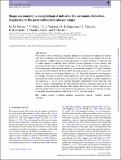Shape asymmetry : a morphological indicator for automatic detection of galaxies in the post-coalescence merger stages
Abstract
We present a new morphological indicator designed for automated recognition of galaxies with faint asymmetric tidal features suggestive of an ongoing or past merger. We use the new indicator, together with pre-existing diagnostics of galaxy structure to study the role of galaxy mergers in inducing (post-) starburst spectral signatures in local galaxies, and investigate whether (post-) starburst galaxies play a role in the build-up of the ‘red sequence’. Our morphological and structural analysis of an evolutionary sample of 335 (post-) starburst galaxies in the Sloan Digital Sky Survey DR7 with starburst ages 0 < tSB < 0.6 Gyr, shows that 45 per cent of galaxies with young starbursts (tSB < 0.1 Gyr) show signatures of an ongoing or past merger. This fraction declines with starburst age, and we find a good agreement between automated and visual classifications. The majority of the oldest (post-) starburst galaxies in our sample (tSB ∼ 0.6 Gyr) have structural properties characteristic of early-type discs and are not as highly concentrated as the fully quenched galaxies commonly found on the ‘red sequence’ in the present day Universe. This suggests that, if (post-) starburst galaxies are a transition phase between active star-formation and quiescence, they do not attain the structure of presently quenched galaxies within the first 0.6 Gyr after the starburst.
Citation
Pawlik , M , Wild , V , Walcher , C J , Johansson , P H , Villforth , C , Rowlands , K E , Mendez Abreu , J & Hewlett , T 2016 , ' Shape asymmetry : a morphological indicator for automatic detection of galaxies in the post-coalescence merger stages ' , Monthly Notices of the Royal Astronomical Society , vol. 456 , no. 3 , pp. 3032-3052 . https://doi.org/10.1093/mnras/stv2878
Publication
Monthly Notices of the Royal Astronomical Society
Status
Peer reviewed
ISSN
0035-8711Type
Journal article
Description
MMP and VW acknowledge support from the European Career Reintegration Grant Phiz-Ev (P.I. VW). VW, KR and JM-A acknowledge support from the European Research Council Starting Grant SEDMorph (P.I. VW). CJW acknowledges support through the Marie Curie Career Integration Grant 303912. PHJ acknowledges the support of the Academy of Finland grant 1274931.Collections
Items in the St Andrews Research Repository are protected by copyright, with all rights reserved, unless otherwise indicated.
Related items
Showing items related by title, author, creator and subject.
-
SDSS-IV MaNGA: How the stellar populations of passive central galaxies depend on stellar and halo mass
Oyarzún, Grecco A.; Bundy, Kevin; Westfall, Kyle B.; Tinker, Jeremy L.; Belfiore, Francesco; Argudo-Fernández, Maria; Zheng, Zheng; Conroy, Charlie; Masters, Karen L.; Wake, David; Law, David R.; McDermid, Richard M.; Aragón-Salamanca, Alfonso; Parikh, Taniya; Yan, Renbin; Bershady, Matthew; Sánchez, Sebastián F.; Andrews, Brett H.; Fernández-Trincado, José G.; Lane, Richard R.; Bizyaev, D.; Boardman, Nicholas Fraser; Lacerna, Ivan; Brownstein, J. R.; Drory, Niv; Zhang, Kai (2022-07-06) - Journal articleWe analyze spatially resolved and co-added SDSS-IV MaNGA spectra with signal-to-noise ratio ∼100 from 2200 passive central galaxies (z ∼ 0.05) to understand how central galaxy assembly depends on stellar mass (M*) and halo ... -
Secular-and merger-built bulges in barred galaxies
Mendez Abreu, Jairo; Debattista, V. P.; Corsini, E. M.; Aguerri, J. A. L. (2014-12) - Journal articleContext. Historically, galaxy bulges were thought to be single-component objects at the center of galaxies. However, this picture is now questioned since different bulge types with different formation paths, namely classical ... -
Galaxy And Mass Assembly (GAMA) : galaxy close pairs, mergers and the future fate of stellar mass
Robotham, A. S. G.; Driver, S. P.; Davies, L. J. M.; Hopkins, A. M.; Baldry, I. K.; Agius, N. K.; Bauer, A. E.; Bland-Hawthorn, J.; Brough, S.; Brown, M. J. I.; Cluver, M.; De Propris, R.; Drinkwater, M. J.; Holwerda, B. W.; Kelvin, L. S.; Lara-Lopez, M. A.; Liske, J.; Lopez-Sanchez, A. R.; Loveday, J.; Mahajan, S.; McNaught-Roberts, T.; Moffett, A.; Norberg, P.; Obreschkow, D.; Owers, M. S.; Penny, S. J.; Pimbblet, K.; Prescott, M.; Taylor, E. N.; van Kampen, E.; Wilkins, S. M. (2014-11-11) - Journal articleWe use a highly complete subset of the Galaxy And Mass Assembly II (GAMA-II) redshift sample to fully describe the stellar mass dependence of close pairs and mergers between 10(8) and 10(12)M(circle dot). Using the analytic ...

